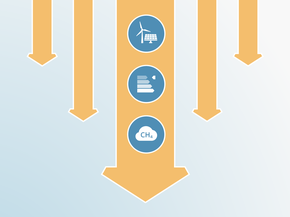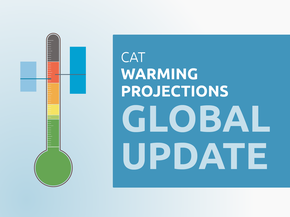Country summary
Overview
While it still needs to take action to meet its strengthened climate target, South Africa is making some progress on policies that address the current energy crisis and its severe social, economic, and environmental implications.
In October 2021, the government set a new and stronger 2030 target range, but domestic policies and their successful implementation will need an additional boost to meet it. The new target represents a significant change compared to the previous target, providing a good example on how governments can increase their mitigation ambition over time. Despite being a step in the right direction, the updated target is not yet compatible with limiting warming to 1.5°C.
Uncertainty on the successful implementation of the Integrated Resource Plan (IRP2019) remains high, given state-owned utility giant Eskom’s unresolved financial and operational problems.
The South African government recently made two promising announcements to address the current energy crisis.
In July 2022, President Ramaphosa further announced a wide-ranging list of actions to address the South African electricity crisis. These include potentially impactful measures to stabilise and decarbonise the South African electricity system, such as removing licencing requirements for distributed energy generation, and unbundling state-owned utility Eskom into three entities for generation, transmission, and distribution.
However, uncertainty on the implementation of both announcements remains high for the time being given the government’s mixed messages on the transition to zero carbon electricity system in recent years, and the ongoing delay in implementing existing policies.
Since the Just Energy Transition Partnership (JETP) was first announced at COP26, South Africa and several donor countries intend to approve its investment plan by the end of 2022. The partnership aims to channel around USD 8.5bn of grants and concessional finance over three to five years to accelerate the retirement of coal plants, the deployment of renewable energy, repurposing mine sites, and supporting green hydrogen and low-carbon transport technologies.
If successfully implemented, this country-led process by the South African government, that puts a distinct focus on a Just Transition, has the potential to become a ‘blueprint’ for other recipient countries and for donor countries to provide effective climate finance.
The CAT rates South Africa’s climate targets and policies as “Insufficient”. The “Insufficient” rating indicates that South Africa’s climate policies and commitments need substantial improvements to be consistent with the Paris Agreement’s 1.5°C temperature limit.
South Africa’s updated 2030 NDC target is rated as “Almost sufficient” when compared to modelled domestic pathways, and “Insufficient” when compared with its fair share contribution to climate action. South Africa’s targets and policies are not stringent enough to limit warming to 1.5°C. If fully implemented, South Africa’s current policies would result in emissions reductions only in line with holding global warming at—but not well below—2°C.
The updated 2030 emissions reduction target submitted to the UNFCCC in September 2021 follows the Presidential Climate Commission recommending 350–420 MtCO2e (incl. LULUCF). As previously analysed by the CAT, the lower end of this range is close to being 1.5°C compatible.
South Africa’s 2030 NDC target has a range, of which we rate the upper end, because reaching that would comply with the NDC.
We rate South Africa’s current policies and actions as “Insufficient”. The “Insufficient” rating indicates that South Africa’s climate policies and action in 2030 need substantial improvements to be consistent with the 1.5°C temperature limit. If all countries were to follow South Africa’s approach, warming would reach over 2°C and up to 3°C.
Under current policies, South Africa will not reduce emissions enough to meet its NDC target range for 2030.
Prior to the pandemic, the South African Cabinet finally approved the long-awaited Integrated Resource Plan (IRP2019) in October 2019 after long delays in the political process. The final plan marked a major shift in electricity policy away from coal towards renewables, which is remarkable for a coal-dominated country like South Africa.
The timely and full implementation of the IRP2019 and other flagship policies like the Green Transport Strategy remain uncertain, given the lack of progress in recent years and missing political leadership to take required measures.
Two recent announcements—the establishment of the Just Energy Transition Partnership (JETP) and a range of potentially far-reaching actions to address the energy crisis—sent positive signals in the right direction but remain highly uncertain given the government’s track record to effectively implement announced policies over the last years.
If considering South Africa’s planned but not yet implemented policies, our rating of policies and actions would go up to “Almost sufficient”. The stringent implementation of proposed economy-wide and sector-specific policy measures would enable South Africa to get close to achieving its 2030 target.
The full policies and action analysis can be found here.
We rate the updated 2030 NDC target levels as “Almost sufficient” when compared to modelled emissions pathways. The “Almost sufficient” rating indicates that South Africa’s NDC in 2030 is not yet consistent with limiting warming to 1.5°C but could be with moderate improvements. If all countries were to follow South Africa’s approach, warming could be held at—but not well below—2°C.
Our methods do not provide a clear answer for the need for finance for South Africa. On balance, the CAT methodology shows that provision of a small but important amount of international support is consistent with the wide range of literature on fair share contributions to meeting the Paris Agreement's goals.
South Africa currently relies on foreign investments and international finance support to implement a large percentage of its climate change programmes, and the government also emphasises in its updated NDC that the implementation of its NDC will be enabled by financial support as specified in the Paris Agreement.
We rate South Africa’s 2030 NDC target as “Insufficient” when compared with its fair share contribution to climate action. The “Insufficient” rating indicates that South Africa's NDC target in 2030 need substantial improvements to be consistent with limiting warming to 1.5°C. If all countries were to follow South Africa’s approach, warming would reach over 2°C and up to 3°C.
CAT interprets the full NDC target as unconditional. As South Africa only needs to reach the upper end of the target range to fulfil the NDC, we rate that emissions level. If South Africa committed to meeting the lower end of its target range, the rating would change to “Almost sufficient”, but close to the border to “1.5°C compatible”, when compared to modelled domestic pathways, and to “Almost sufficient” when compared to the fair share contribution.
The CAT currently does not evaluate South Africa’s net zero target given its preliminary nature and a lack of more detailed information. The CAT will do so once further information is communicated by the government.
Further analysis
Latest publications
Stay informed
Subscribe to our newsletter




